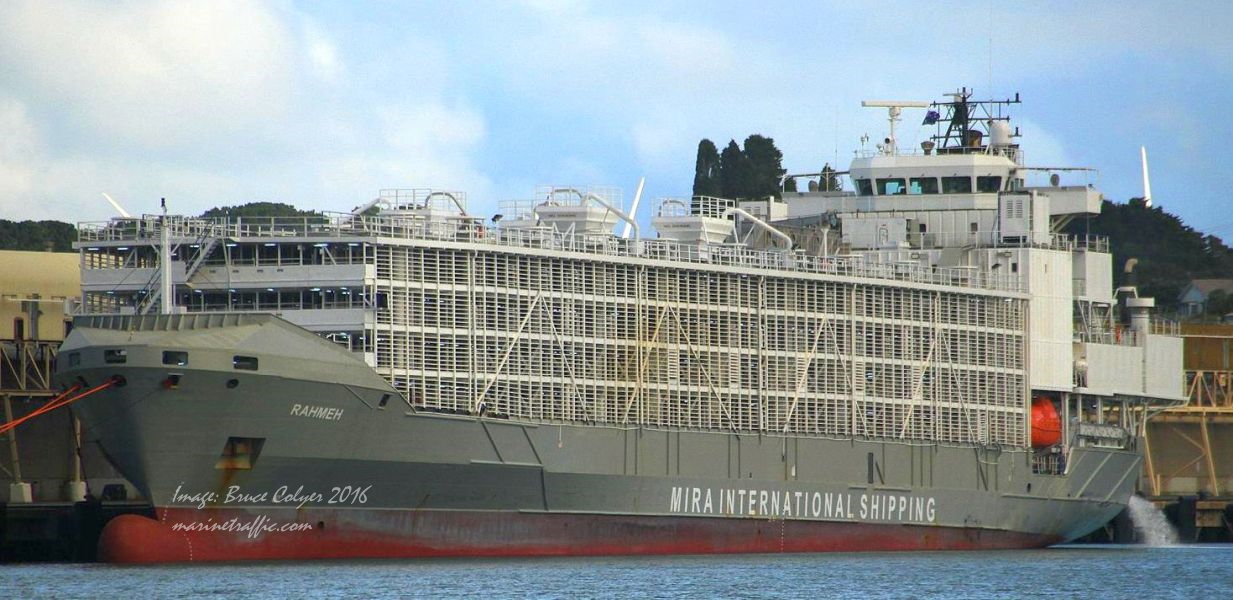Tragically, MV Gulf Livestock 1 struck a typhoon whilst en route to China from New Zealand in September 2020. All but two of the 43 crew and all 5,867 heifers on board perished, demonstrating just how risky live animal export is for human and non-human animals. The event was a large contributing factor in New Zealand’s decision to ban all live animal exports by sea (effective April 2023).
The ship had loaded cattle in Gladstone, Queensland that very month. Would the Australian government have a more favourable opinion on banning all live exports by sea had the ship originated from Australia on this fateful voyage?
Built in 2002, at 20 years old, the Gulf Livestock 1 was by no means the oldest vessel servicing Australia or New Zealand.
The Al Messilah is a converted car carrier, built in 1980, making it, at 42 years old, the oldest vessel still regularly conveying sheep and cattle from Australia to the Middle East. The Maysora, built in 1989, recently loaded sheep and cattle in Fremantle, bound for Israel. Several other vessels still plying their shameful trade from Australia were built in the 1990s.

Al Messilah loading at Fremantle
I struggle to imagine the abject terror experienced by the Gulf Livestock 1 crew as they realised the inescapable truth of what was happening. The cows were perhaps better off not knowing, but for any animal used to firm ground and open skies, it would have been incomprehensibly frightening.
Our records only go back to 1980 and these are only the events that were so calamitous that they were reported; sheep and cattle die or are frequently euthanised for injuries sustained during rough weather – it’s routine; well over 1 million sheep and cattle have died at sea en route to foreign countries for slaughter in the past 40 years. How many tragedies now?
1981: In an at-sea transfer of animals from the Kahleej Express to the Al Shuwaikh, 635 sheep died
1996: When the Guernsey Express sank after taking water on its way to Osaka from Australia, 1,592 cattle drowned.
1998: The MV ‘Charolais Express’ hit heavy weather on route from Bunbury (WA) to Jordan in July. Of the 1,200 loaded, 346 cattle are reported to have died due to inadequate ventilation. Fifty cattle then died in a Jordanian port, and a further 174 were injured or ill and were subsequently rejected by Jordan, then by Yemen, and ultimately disposed of at sea.
1999: Some 800 cattle were loaded onto the ‘Kalymnian Express’ in December 1999 in Western Australia bound for Indonesia. Over 300 cattle died of injuries, or were destroyed later due to their injuries, when the ship met a cyclone off the northwest coast of Western Australia.
2002: Ninety-nine cattle died on the NV Norvantes en route to Jakarta in February when the ship hit bad weather. The vessel left Darwin carrying 1,169 cattle.
2005: The MV Maysora was delayed fully laden with 80,000 sheep in Fremantle harbour when engine problems occurred. What if the engine problems had occurred in the middle of the Indian Ocean?
2007: A ship with 1,695 cattle on board traveling from Fremantle to Jakarta was battered by a cyclone. 68 cattle died (4.01%) during the 8-day voyage.
2019 November: When the Queen Hind capsized in the Black Sea off the coast of Romania, 14,600 sheep drowned (not Australian animals). Secret decks were found, which would have allowed overstocking.
2020: September: The Gulf Livestock 1, carrying 43 crew members and 5,867 heifers to China from New Zealand (not Australian animals) sank off the coast of Japan after reportedly losing an engine in rough seas caused by Typhoon Maysak. All crew except two, and all cows perished.
2022 June: The Badr 1, carrying 15,800 sheep (not Australian animals) – several thousand more than it was built to carry – sank in Sudan’s Red Sea port of Suakin. Omar al-Khalifa, the head of the national exporters’ association, said the ship took several hours to sink at the pier – a window that suggested it “could have been rescued”. All sheep drowned except 700 who were rescued, but they are in very poor condition and not expected to live.

The ill-fated Gulf Livestock 1 loading in Portland, Victoria when it was MV Rahmeh
But these are “only” those disasters caused by storms or ships simply “sinking”. There are some 27 other disasters involving fire, ventilation system failure, shipment rejections by importing countries, and “heat events” in which many hundreds of thousands of animals died and many more millions suffered. Animals used to pasture and open skies, and huge, sea-going vessels just don’t mix, and this is why we will keep the pressure on this government to end live sheep exports as soon as possible and then get all animals of these ships of shame.
ABC’s investigation into that tragedy – ‘Into the Storm’ can be found HERE.
Katrina Love, Campaign Manager
